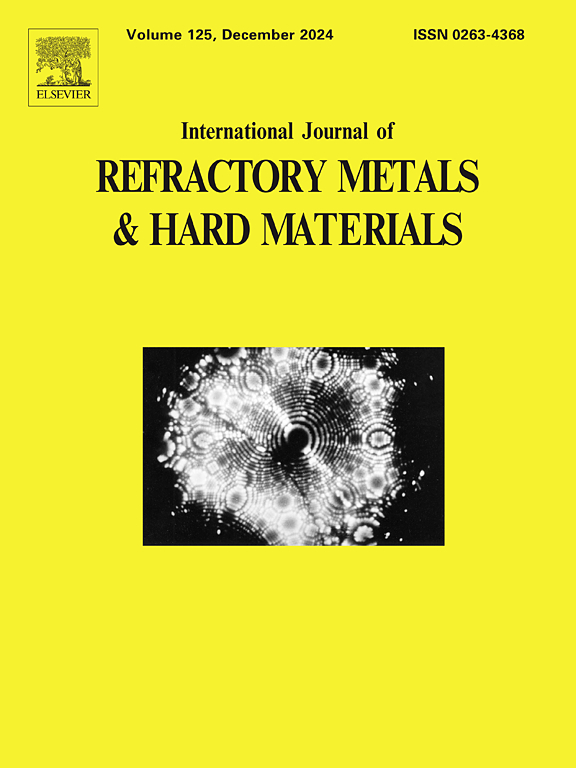Wear and corrosion behaviors of Ti-6Al-4 V alloy gradient-hardened by vacuum rapid oxynitriding
IF 4.6
2区 材料科学
Q2 MATERIALS SCIENCE, MULTIDISCIPLINARY
International Journal of Refractory Metals & Hard Materials
Pub Date : 2025-07-09
DOI:10.1016/j.ijrmhm.2025.107317
引用次数: 0
Abstract
Aircraft parts, particularly engine fan blades, require composite improvements in wear and corrosion owing to continuous particle impact and repeated exposure to low and ambient temperatures. Titanium alloys, which are known for their inherent TiO2, provide excellent corrosion resistance and superior strength. Thus, they are effectively utilized to enhance fuel efficiency, making them a preferred material for many fan-blade applications. However, the low wear resistance of titanium alloys shortens the lifespan of materials because erosion and wear occurs due to particle impact. Therefore, this study aims to form a hardened surface layer on a Ti-6Al-4 V alloy using a highly efficient and economical vacuum rapid oxynitriding process by mixing N and O gases. Most previous studies have focused solely on the wear characteristics resulting from the surface hardening of the Ti-6Al-4 V alloy due to the addition of nitrogen alone; limited research has been conducted on the surface-hardening mechanism with a mixture of N and O gases. Furthermore, the wear and corrosion properties have been evaluated independently in separate environments, which has resulted in a lack of research on the combined effects of corrosion and wear. Therefore, this study systematically elucidates the corrosion, wear, and combined corrosion–wear behavior mechanisms of Ti alloys in a 3.5 wt% NaCl environment.
真空快速氧氮化梯度硬化ti - 6al - 4v合金的磨损和腐蚀行为
飞机部件,特别是发动机风扇叶片,由于持续的颗粒撞击和反复暴露在低温和环境温度下,需要改进磨损和腐蚀的复合材料。钛合金以其固有的二氧化钛而闻名,具有优异的耐腐蚀性和超强的强度。因此,它们被有效地用于提高燃油效率,使它们成为许多风扇叶片应用的首选材料。然而,钛合金的低耐磨性缩短了材料的使用寿命,因为颗粒撞击会产生侵蚀和磨损。因此,本研究旨在采用高效经济的真空快速氮化工艺,通过混合N和O气体,在ti - 6al - 4v合金表面形成硬化层。以往的研究大多集中在单纯添加氮导致ti - 6al - 4v合金表面硬化的磨损特性上;对氮氧混合气体的表面硬化机理进行了有限的研究。此外,磨损和腐蚀性能是在单独的环境中单独评估的,这导致缺乏对腐蚀和磨损综合影响的研究。因此,本研究系统地阐明了钛合金在3.5 wt% NaCl环境下的腐蚀、磨损和复合腐蚀磨损行为机制。
本文章由计算机程序翻译,如有差异,请以英文原文为准。
求助全文
约1分钟内获得全文
求助全文
来源期刊
CiteScore
7.00
自引率
13.90%
发文量
236
审稿时长
35 days
期刊介绍:
The International Journal of Refractory Metals and Hard Materials (IJRMHM) publishes original research articles concerned with all aspects of refractory metals and hard materials. Refractory metals are defined as metals with melting points higher than 1800 °C. These are tungsten, molybdenum, chromium, tantalum, niobium, hafnium, and rhenium, as well as many compounds and alloys based thereupon. Hard materials that are included in the scope of this journal are defined as materials with hardness values higher than 1000 kg/mm2, primarily intended for applications as manufacturing tools or wear resistant components in mechanical systems. Thus they encompass carbides, nitrides and borides of metals, and related compounds. A special focus of this journal is put on the family of hardmetals, which is also known as cemented tungsten carbide, and cermets which are based on titanium carbide and carbonitrides with or without a metal binder. Ceramics and superhard materials including diamond and cubic boron nitride may also be accepted provided the subject material is presented as hard materials as defined above.

 求助内容:
求助内容: 应助结果提醒方式:
应助结果提醒方式:


